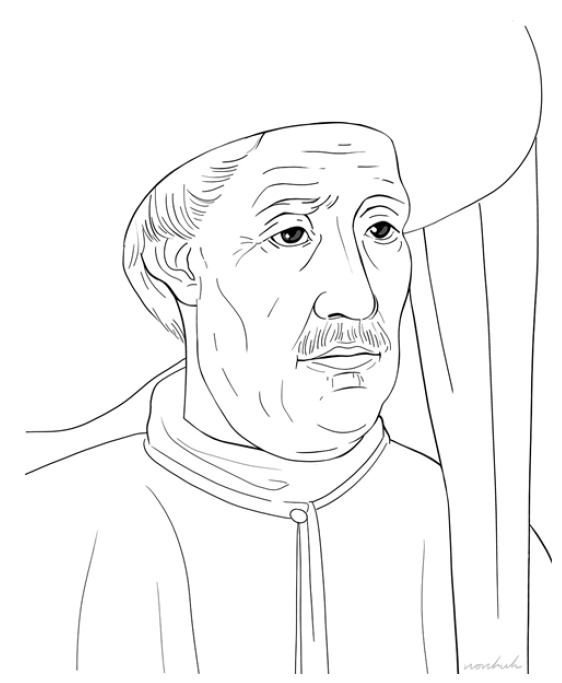Onde a terra se acaba e o mar começa [(Here is) Where the land ends and the sea begins].
—Luís de Camões (1527–1580)
The reason I chose to visit Lisbon this autumn was to enjoy walking through the beautiful alley seen in the movie Night Train to Lisbon (starring Jeremy Irons, directed by Bille August, 2013). In the movie, a Latin language teacher travels to Lisbon in the hope of discovering the fate of an author of a book, a doctor and a poet.
As well as the charming places in the movie, the most impressive place was Jerónimos Monastery near the river Tragus. The south entrance of this monastery is a shrine-like portal with many carved figures. A statue of Henry the Navigator (1394–1460) was standing on a pedestal between the two doors (Fig. 1). Upon entering this portal, there was a church. Inside this church, I saw two stone tombs that were supported by six stone lions at the lower choir of this church. A sailing boat was carved on the tomb of Vasco da Gama (1468–1523). A lute and a pen were carved on the tomb of Luís de Camões (1527–1580).
As known, Prince Henry the Navigator is regarded as the main initiator of the Age of Discovery through his administrative directions, such as establishing shipbuilding and sailing schools and supporting the discoveries of sailors who were trying to find a new maritime route. He was a central figure in the 15th-century European maritime discoveries and expansion. This church (dedicated to Santa Maria de Belém) was initially built by Henry the Navigator. Before departing the port, explorers spent the night in this church praying for their success and safe return. When Vasco da Gama and his crew started their adventure to India in 1497, they spent the night in prayer here before departing. His voyage to India by way of Cape of Good Hope was the first to link Europe and Asia by an ocean route, connecting the Atlantic and the Indian oceans and opening the way to global multiculturalism. In honor of Vasco da Gama, Luís de Camões wrote an epic poem, Os Lusíadas (The Lusiads).
At Cabo da Roca, or Cape Roca, a cape on the westernmost point of Portugal, of continental Europe, and of the Eurasian landmass, I again saw a part of the poem written by Luís de Camões on a monument: “Onde a terra se acaba e o mar começa [(Here is) Where the land ends and the sea begins].”
Standing on the edge of the land in front of an ocean, I thought about the role of the authors of the journal (surgeons, researchers) who are standing on the edge of discovering knowledge and skills that have remained undiscovered. And the role of the editor who signpost the path towards the researchers are going.
Editors are faced with the task of understanding the degree to which reviewers agree and then deciding whether to reject or accept an author's submission based on its inherent quality. In some cases, editors should play the role of a “devil's referee” [1], while in other cases, they should follow the example of Harriet Shaw Weaver, who published James Joyce’s Ulysses at her own expense [2]. Editors are core stakeholders in several regards, who is both responsible to and depends upon all other people involved in the journal. One responsibility of an editor is to try to have the journal included in as many databases as possible so that its papers will be easily accessible to readers. Simultaneously, an editor relies on authors to submit high-quality papers that will attract readers’ interest. A major goal of an editor is for his or her journal’s publications to be cited by other researchers, publishing either in the same journal or in other journals, in order to increase the journal’s impact factor. Therefore, an editor welcomes submissions with a substantial degree of originality, which increases their likelihood of being cited in the future [3].
Like Vasco da Gama, many authors of our journal have succeeded in going around “Cape of Good Hope” and had their submitted papers accepted, and these papers are still being cited frequently.
After returning home, I found and read the English edition of Os Lusíadas [4]. Written in 1,102 stanzas in the Homeric fashion, the poem focuses on a fantastic interpretation of the Portuguese voyages of discovery during the 15th and 16th centuries, and celebrates the discovery of a sea route to India by Vasco da Gama.
As an editorial board member and a poet, I would like to write editorials that may be helpful to our readers. I sincerely want to find the way to become a “good trauma surgeon.”
ARTICLE INFORMATION
-
Ethics statements
Not applicable.
-
Conflicts of interest
The author has no conflict of interest to declare.
-
Funding
This work was supported by the National Research Foundation of Korea (NRF) grant (No. NRF-2020R1I1A2054761) funded by the Ministry of Science and ICT of Korea.
The author is grateful to Hye Won Hu, MA (Department of Oral Biology, Yonsei University College of Dentistry, Seoul, Korea) for her illustration.
Fig. 1.Portrait of Henry the Navigator. Illustration by Hye Won Hu, MA.

REFERENCES
- 1. Hwang K. The editor's role as a Harriet Shaw Weaver. Arch Plast Surg 2014;41:109–10. ArticlePubMedPMC
- 2. Hwang K. The need for a reviewer to play devil's advocate. Arch Plast Surg 2013;40:171–2. ArticlePubMedPMC
- 3. Hwang K. Appropriate roles for the subscriber, publisher, editor, author, and reviewer in the Archives of Plastic Surgery. Arch Plast Surg 2013;40:663–5. ArticlePubMedPMC
- 4. de Camoes LV. The Lusiads. Burton RF, translator. Tinsley Brothers; 1880.
Citations
Citations to this article as recorded by



 KST
KST


 PubReader
PubReader ePub Link
ePub Link Cite
Cite


